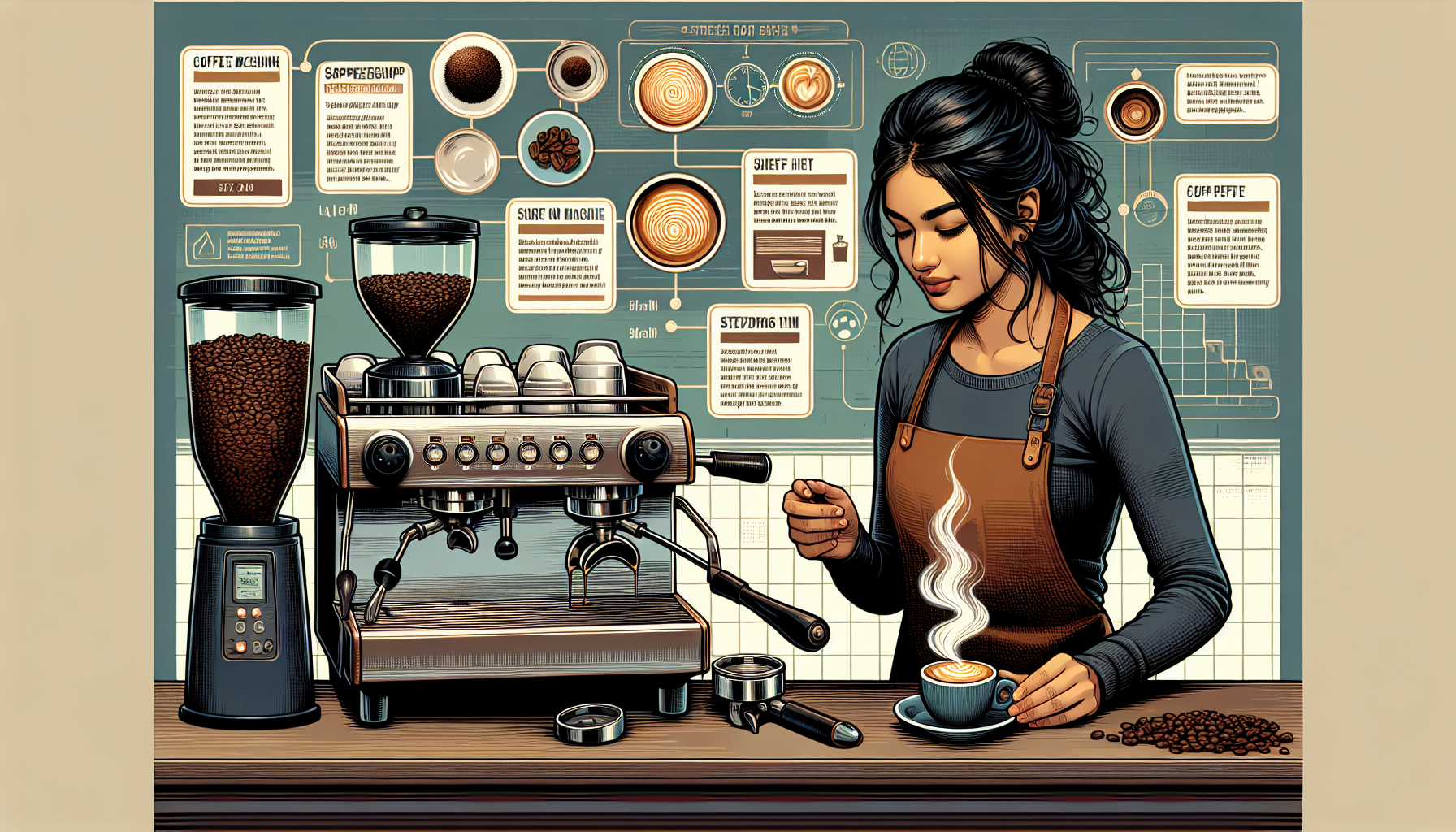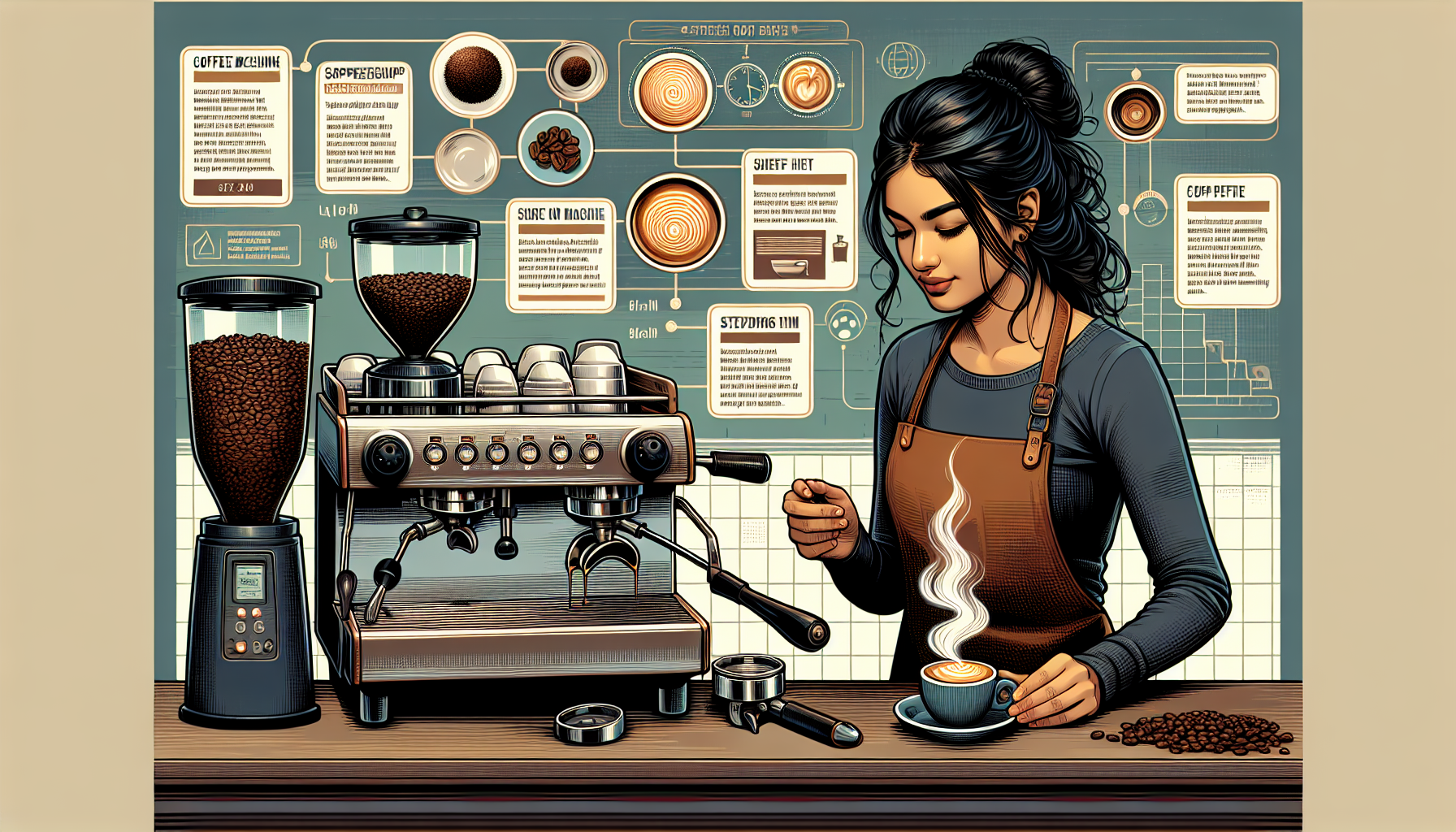Are you curious about whether using an espresso machine is difficult or not? Well, fret no more, because we’ve got the answer for you! In this article, we’ll explore the world of espresso machines and discover just how easy it is to become your very own barista. So, sit back, relax, and get ready to unleash your inner coffee connoisseur as we dive into the wonderful realm of espresso machines. No, using an espresso machine is actually quite easy once you understand how it works. Not only can it produce a consistently delicious cup of coffee, but it also saves you time and money in the long run. In this article, we will explore the benefits of using an espresso machine, walk you through the process of understanding and operating the machine, discuss common challenges and solutions, and provide some tips for easy espresso machine usage.

CHECK OUT ESPRESSO MACHINES ON AMAZON
Benefits of Using an Espresso Machine
Consistency of Taste
One of the major benefits of using an espresso machine is the consistency of taste it offers. Unlike other coffee brewing methods, an espresso machine allows for precise control over variables such as water temperature, pressure, and extraction time. This means that once you find the perfect recipe, you can expect the same great taste in every cup of espresso you make. Whether you prefer a bold and rich flavor or a smooth and mellow one, an espresso machine can help you achieve your desired taste consistently.
Time Efficiency
Another advantage of using an espresso machine is the time efficiency it provides. While other brewing methods may require you to wait for the water to come to a boil or for the coffee to steep, an espresso machine is capable of producing a shot of espresso in just a matter of seconds. This is especially beneficial for busy individuals who are always on the go and don’t have the luxury of waiting for a cup of coffee. With an espresso machine, you can enjoy a premium cup of coffee in a fraction of the time.
Cost Effectiveness
Contrary to popular belief, using an espresso machine can actually save you money in the long run. While the initial investment may seem significant, the cost per cup of espresso made at home is significantly lower compared to buying a cup from a coffee shop. By making your own espresso, you can avoid the expensive price tags associated with specialty coffee drinks. Additionally, you have the freedom to experiment with various beans and flavors without having to pay extra. In the end, the cost effectiveness of using an espresso machine becomes evident when you calculate how much money you save over time.
Understanding and Operating an Espresso Machine
To fully enjoy the benefits of using an espresso machine, it is essential to have a good understanding of how it works and how to operate it correctly. Let’s explore the different components of an espresso machine and guide you through the process of preparation, grinding and dosing, tamping and brewing, as well as milk steaming and frothing.
Components of an Espresso Machine
An espresso machine consists of several key components that work together to produce a perfect shot of espresso. These components include a water reservoir, a boiler or thermoblock, a portafilter, a group head, and a steam wand. The water reservoir stores the water used for brewing, while the boiler or thermoblock heats the water to the optimal temperature. The portafilter is where the coffee grounds are placed for brewing, and the group head is the interface between the portafilter and the machine. Lastly, the steam wand is used for steaming and frothing milk. Understanding each of these components and their functions is crucial for operating an espresso machine effectively.
Preparation and Setup
Before you start brewing your espresso, it is important to prepare and set up your machine properly. This involves ensuring that your machine is clean and free from any leftover coffee grounds. You should also check that the water reservoir is filled and that the machine is plugged into a power source. Many espresso machines require some time to heat up, so it is advisable to turn it on and give it a few minutes to reach the desired brewing temperature. By properly preparing and setting up your machine, you can ensure a smooth brewing process and a delicious cup of espresso.
Grinding and Dosing
The next step in using an espresso machine is grinding and dosing the coffee beans. It is recommended to use freshly roasted coffee beans for the best flavor. The grind size is crucial in determining the quality of your espresso, as it affects the extraction process. A finer grind size is typically used for espresso to maximize the extraction of flavors from the coffee grounds. Once you have ground your coffee beans to the appropriate size, you need to dose the ground coffee into the portafilter. The amount of coffee used, known as the dose, can vary depending on personal preference and the type of espresso you want to make. It is essential to achieve a consistent and even distribution of coffee in the portafilter to ensure an even extraction.
Tamping and Brewing
After dosing the coffee, the next step is tamping and brewing. Tamping refers to the process of compressing the coffee grounds in the portafilter using a tamper. This step is crucial for creating a level and uniform surface, which allows for proper water flow and extraction during brewing. The coffee grounds should be evenly distributed and firmly tamped to avoid channeling, which can lead to uneven extraction and a subpar cup of espresso. Once you have tamped the coffee, you can attach the portafilter to the group head and start the brewing process. The espresso machine will push hot water through the coffee grounds at high pressure, resulting in a concentrated shot of espresso.
Milk Steaming and Frothing
If you enjoy milk-based espresso drinks such as lattes or cappuccinos, the final step is the milk steaming and frothing process. This involves using the steam wand to heat and froth the milk, creating a creamy texture for your drink. It is important to position the steam wand correctly and immerse it just below the surface of the milk. By introducing air into the milk while it is being heated, you can create microfoam, which is essential for achieving the desired velvety texture. With the right technique and practice, you can master the art of milk steaming and frothing, adding a delightful touch to your espresso-based beverages.
Common Challenges and Solutions
While using an espresso machine may seem intimidating at first, there are common challenges that many beginners face. Let’s explore some of these challenges and provide solutions to help you overcome them.
Choosing the Right Beans
The quality of your espresso largely depends on the beans you choose. With the vast variety of beans available, it can be challenging to determine which ones are best suited for your taste preferences. To overcome this challenge, it is recommended to experiment with different coffee beans and roasts. Start with a medium roast and try beans from different regions to understand their flavor profiles. Additionally, you can seek recommendations from your local specialty coffee shop or online communities to discover beans that are highly regarded for espresso.
Adjusting Grind Size and Extraction Time
Achieving the perfect extraction requires a combination of the right grind size and extraction time. If your espresso tastes sour or weak, it may be an indication of under-extraction, which means that the water did not extract enough flavor from the coffee grounds. In this case, try using a finer grind size or extending the extraction time. On the other hand, if your espresso tastes bitter or overly strong, it may be a sign of over-extraction. To solve this, you can adjust to a coarser grind size or shorten the extraction time. It may take some trial and error to find the ideal combination, but with practice, you will be able to dial in the perfect extraction.
Maintaining Proper Machine Cleanliness
Keeping your espresso machine clean is essential for optimal performance and flavor. The buildup of coffee oils and residue can negatively impact the taste of your espresso and even damage the machine over time. It is recommended to clean your machine regularly by backflushing with water and using a brush to clean the group head and portafilter. Additionally, it is important to descale your machine periodically to remove mineral deposits that may affect the brewing process. By maintaining proper machine cleanliness, you can ensure the longevity and quality of your espresso machine.
Mastering Milk Frothing Technique
Creating the perfect milk foam for your espresso-based drinks requires practice and technique. Many beginners struggle with achieving the right consistency and texture. To improve your milk frothing technique, start by using cold milk and a clean, properly positioned steam wand. Submerge the wand into the milk slightly below the surface, and gradually introduce air by opening the steam valve. As the milk heats up, lower the steam wand deeper into the milk to ensure even heating and texturing. Practice consistently, and soon you will be able to create velvety microfoam that adds an extra touch of luxury to your beverages.
CHECK OUT ESPRESSO MACHINES ON AMAZON
Training and Practice
To enhance your skills and knowledge in using an espresso machine, training and practice are essential. By investing time and effort in the following areas, you can elevate your espresso brewing experience and become a home barista.
Getting Acquainted with the Machine
Take the time to thoroughly read the user manual provided by the manufacturer. Familiarize yourself with the specific features and functions of your espresso machine. Understanding how all the components work together will enable you to operate the machine with ease and confidence.
Learning Espresso Recipes
Experiment with different espresso recipes to discover your preferred flavors. Start with classic recipes such as the espresso shot, cappuccino, or latte. As you become more comfortable, you can further experiment with different ratios, temperatures, and brewing techniques to create unique espresso-based beverages.
Experimenting with Different Variables
Espresso brewing is an art that allows for endless experimentation. Play around with variables such as water temperature, grind size, pressure, and extraction time to discover how they affect the taste and quality of your espresso. Keep notes of your experiments to remember your favorite combinations.
Seeking Professional Guidance
If you are passionate about espresso and want to take your skills to the next level, consider seeking professional guidance. Attend barista courses or workshops to learn from experienced professionals who can share their expertise and insights. Additionally, online communities and forums dedicated to coffee enthusiasts can be valuable sources of knowledge and support.
Tips for Easy Espresso Machine Usage
To make your espresso machine usage as easy and enjoyable as possible, here are some additional tips to keep in mind:
Investing in a High-Quality Machine
Investing in a high-quality espresso machine can significantly enhance your brewing experience. Look for machines that offer consistent temperature control, adjustable pressure settings, and a sturdy build. While they may be more expensive initially, they often provide better longevity and reliability.
Using Freshly Roasted and Ground Coffee
To achieve the best flavor in your espresso, use freshly roasted coffee beans and grind them just before brewing. Stale coffee beans can result in a dull and lackluster taste. Consider investing in a good grinder to ensure a consistent and precise grind size.
Following the Manufacturer’s Instructions
Carefully follow the manufacturer’s instructions for operating and maintaining your espresso machine. Each machine may have specific requirements and recommendations that are crucial for its optimal performance and longevity. Regular descaling, cleaning, and maintenance are essential to ensure the longevity and quality of your machine.
Regularly Cleaning and Maintaining the Machine
As mentioned earlier, maintaining proper machine cleanliness is key to ensuring the quality of your espresso. Clean the group head and portafilter after each use, and descale the machine periodically as recommended. Regular maintenance will prevent the buildup of coffee oils and mineral deposits, allowing your machine to perform at its best.
Seeking Support from Online Communities
Joining online communities or forums dedicated to espresso enthusiasts can provide a wealth of support and knowledge. You can learn from experienced individuals, share your challenges and achievements, and seek recommendations for beans, recipes, or troubleshooting. Building connections with fellow coffee enthusiasts can enhance your espresso journey and keep you inspired.
In conclusion, using an espresso machine is not difficult at all. With a good understanding of its components and proper training and practice, you can enjoy the benefits of consistency, time efficiency, and cost effectiveness. By overcoming common challenges and following the tips provided, you can easily operate your espresso machine and create delicious coffee beverages in the comfort of your own home. So why not start your espresso adventure today?

